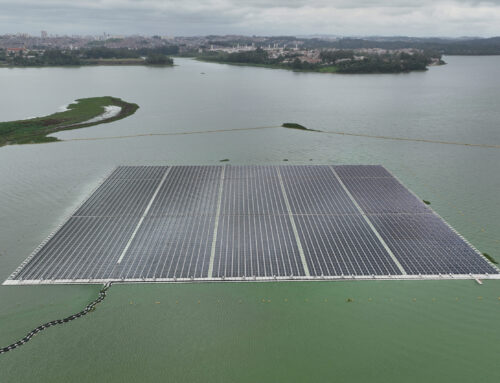Walmart (WMT) Expands EV Charging and Boosts Renewable Energy in Its Net-Zero Playbook
November 28, 2025
Walmart (NYSE: WMT) is stepping up its clean energy and emissions game across the United States. Shoppers want to save money and live more sustainable lives, and Walmart sees a big role for itself in that shift. With a store or club within 10 miles of nearly 90% of Americans, the retailer believes it is perfectly placed to support the country’s move to cleaner transportation.
From expanding EV charging access to using more renewable power and electrifying its delivery fleet, Walmart is building a lower-carbon future that also brings long-term savings and stronger resilience.
Charging Up America: Walmart’s Big EV Push
Walmart wants to make owning an electric car easier for millions of people. The company plans to build its own fast-charging network across thousands of Walmart and Sam’s Club locations by 2030. This will add to the nearly 1,300 chargers already running at more than 280 stores today.
The goal is simple: remove the fear of not finding a safe and reliable place to charge. Walmart’s well-lit parking lots offer an easy place to plug in while customers shop, grab groceries, or pick up essentials. And in true Walmart style, the company aims to offer low-cost charging to help families save on transportation—the second-largest expense for most households.

Greener Deliveries and Next-Gen Fleet
Transportation is one of Walmart’s toughest emissions issues. In 2024, the company’s fleet made up 24.9% of Scope 1 emissions and 14.4% of total operational emissions. As Walmart brings more logistics in-house and grows its business, fleet emissions may rise in the short term.
Yet Walmart is preparing for a cleaner future. It’s partnering with GM, Ford, and Canoo to electrify delivery vehicles. Many Walmart+ deliveries already use electric vans.
- They are also testing heavy-duty battery trucks, hydrogen fuel cell vehicles, and renewable diesel.
- Walmart is rolling out liquid hydrogen-powered forklifts and recently opened Latin America’s first industrial-scale renewable hydrogen plant in Chile.
- Electric yard trucks are already delivering major gains—cutting emissions by more than 75% per hour compared to diesel models.
These tests matter. They help shape the future of Walmart’s fleet, especially as long-haul truck solutions may not mature until the 2030s.
As more drivers go electric, the re network will add much-needed charging options nationwide. Even rural areas, which often lack EV infrastructure, will benefit. Walmart sees this as a smart business move and a natural extension of its mission to help customers live better and more sustainably.
Smart Stores with Clean Energy
Walmart’s clean energy plan centers on four ideas: access, cost, resilience, and emissions cuts. Because its stores rely more than ever on electricity and digital systems, stable power is essential. So Walmart is investing in new technology to identify power risks, upgrade monitoring tools, and strengthen connections to the grid.
Real-time energy monitoring across thousands of facilities helps Walmart track usage and operate more efficiently. These insights will matter even more as automation grows across the company’s operations.
Walmart is also adding more on-site power. Solar panels, wind systems, and battery storage help stores stay open during outages and lower long-term energy bills. Between 2024 and 2030, it aims to support up to 10 gigawatts of new clean energy capacity.
The company is already making progress. In 2024, renewable energy met 48.5% of Walmart’s global electricity needs. This brings the retailer close to its goal of 50% renewable power by 2025 and puts it on track for 100% by 2035. By the end of 2024, its U.S. operations had 166 MW of onsite solar across 325 facilities and 10 MW of energy storage at 44 locations.


Achieving Net-Zero Emissions
Walmart is working toward zero emissions across its global operations (Scope 1 and 2) by 2040. These emissions come from transport fuels, refrigeration, heating, and electricity use.
The company has reduced its emissions intensity by 47.4% since 2015, but annual emissions can still vary. In 2024, Walmart’s Scope 1 and 2 emissions rose by 1.1%. Growth in U.S. transportation and lower renewable energy output in Mexico and Central America—due to extreme heat and drought—played a big role.
Still, global operational emissions remain 18.1% lower than the 2015 baseline. But progress won’t always be smooth. Policies, infrastructure limits, equipment shortages, and slow advances in low-carbon trucking technology create challenges. Walmart has noted that meeting its 2025 and 2030 targets may take more time.
Even so, Walmart keeps improving. New buildings and remodels use efficient lighting, HVAC systems, and refrigeration. The company is replacing older equipment with high-efficiency models and testing refrigeration and HVAC systems with lower global warming impact. These upgrades support both sustainability and cost savings.


Walmart (WMT) Q3 FY2025 Highlights
Walmart Inc. posted Q3 FY2025 revenue of $179.5 billion, up 5.8% from last year and beating estimates by 1.1%. Same-store sales rose 4.5%, fueled by strong e-commerce and retail growth, with adjusted EPS at $0.62—above expectations. The company raised its full-year sales outlook amid steady demand and efficiency gains.
Additionally, WMT stock hit near-record highs but with a “Moderate Buy” rating from analysts, targeting 6-9% upside. Growth drivers include e-commerce, consumer resilience, and clean energy bets like EV fleets and chargers.
The goals are bold: zero operational emissions by 2040 and 100% renewable power by 2035. Yet Walmart’s scale, resources, and willingness to innovate give it a powerful role in America’s clean energy transition. And ultimately, these steps help customers live better, save more, and make sustainable choices that fit their everyday lives.
Search
RECENT PRESS RELEASES
Related Post




